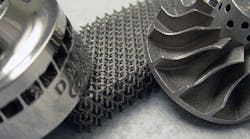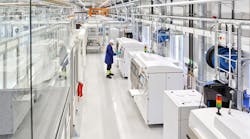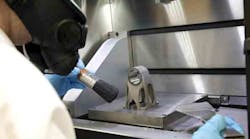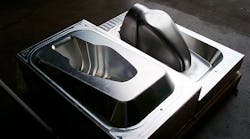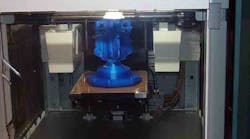When a serious publication like Harvard Business Review declares, “3D printing is changing the way we think,” only those business owners with a head-in-the-sand mentality are going to dismiss it as more academia rhetoric. And they’d be making a mistake.
Recently the HBR asserted that over 30% of the top 300 largest global brands now are using or evaluating 3D printing, whether to prototype new products or conduct other innovation projects, or to perform actual production of what they sell. “To my mind,” wrote Dartmouth’s Richard D’Aveni, “there is no question that 3D has reached a tipping point.” The report looks at the current status of the 3D printing industry and in doing so makes a bold prediction: “The question is not if, but when companies need to start considering 3D printing.
This means that 2016 very well may be a watershed year for manufacturing, and those businesses that are still on the fence about the advantages of 3D printing soon might find themselves falling into a deep, dark chasm of financial heartache. With this understanding as our premise, we came up with five reasons that 3D printing needs to be in your business plan for 2016.
1. Time to market. Computer-aided design (CAD) software emerged as a great tool for shaping an idea into a product. But, there is nothing better than designing real-life scenarios in order to gain the proper feedback on a design. By using 3D printing, manufacturers are able to cut out much of their secondary tooling processes, such as injection molding, resin tooling, mold making, and soft tooling. A design engineer could have a new product idea on Tuesday, design a CAD drawing of it on Wednesday morning, and print a 3D part to have in-hand for the sales department’s customer meeting on Wednesday afternoon. Rapid prototyping virtually eliminates the need for preproduction tooling and speculative manufacturing while helping them shorten their time to market.
Fast prototyping support means faster product evaluation. Faster product evaluation means faster time to finalized designs. Faster finalized designs means faster time to production and to market. Faster time to market is a tremendous competitive advantage.
2. Helping the bottom-line. During a case study session at a major design and manufacturing trade event, construction and mining equipment manufacturer Caterpillar showed how it saved money by 3D printing low-volume parts, including hose clamps, gauges, chain links, and scale models of various kinds. In one example, the company reported it saved about $160,000 by 3D printing track links for a tractor.
What we found is that you just set the printer down and there are all kinds of jobs waiting for it,” noted Jim LaHood, engineering specialist for 3D printing at Caterpillar, remarking about the demand for 3D printing and additive manufacturing technology within his company.
Now, items can be mass-produced without high fixed-capital costs related to their specific design. For a major sporting goods manufacturer, we prototyped four dozen balls, each with different dimple arrays, in a matter of two days. These balls were blown through a wind tunnel to see how they would react for speed and accuracy – something that would never have been possible before with traditional manufacturing processes and the high costs often associated with production.
3. Pre-marketing capabilities. 3D printed parts are useful for communicating the design intent to marketing and sales departments, as well as manufacturers and suppliers. After seeing and handling the 3D printed version of the product, marketing and sales will be better prepared to support it when it is released. Sharing the printed model with manufacturing and supply chains will help to determine if the product can be economically manufactured, and to identify potential issues that may emerge during manufacturing. Giving manufacturers and suppliers an accurate representation of the end product could help prevent any miscommunication that may happen when interpreting the CAD models.
4. Seeing is believing. The ability to see and touch something that is realistic and feels like a finished product helps confirm the goals established for the product have been met. This builds faith in the product within an organization, and it can help gain funding from potential investors. Field-testing a prototype identical to manufactured parts will provide valuable design and manufacturing data and could prevent costly mistakes and rework later.
5. Working within the budget. We hear it all the time from business owners: "Wow, that could really help my business, but I am not ready just yet to invest in a high-end, 3D printer.” This is the reason some companies have worked around budgetary restrictions and enlisted a service bureau to convert their CAD designs into 3D-printed parts.
Enlisting the capabilities of a manufacturing service bureau is a great option for companies that do not have the volume demand or fiscal resources to purchase a 3D printer of their very own. It also is a terrific way for those who have never been exposed to 3D printing to evaluate specific technologies, applications, and materials that may be useful to their businesses.
If you are a small start-up or an inventor who has come up with the "next big thing," many service bureaus are staffed with engineers with whom you can collaborate to advance your concept. Engineering assistance helps to create, design, and select the right prototype materials – and usually at no cost, or at significantly less cost than engaging a product-development or design firm.
The takeaway is this: Companies that thrive in the marketplace and consistently beat out their competition are the ones that continue to invest in their design and manufacturing processes. The objective for all successful businesses is to continue to create the best and most affordable product and get them to their customers as quickly, efficiently and cost effectively as possible.
Historically, for a car company to make a sample side-view mirror, it takes days and costs thousands of dollars,” according to Deloitte research director Duncan Stewart. “On a 3D printer, you enter a computer design file, press a button, and the object comes out in a few hours. The value is in saving money and in speeding up production. It’s all about time to market.
3D printing gives companies the ability to achieve all these goals. And those businesses that aren't staying up with current technology will discover their competition is going to start gaining an edge. That is if they haven’t already.
Andy Coutu is the CEO of R&D Technologies Inc. in North Kingstown, RI. Justin Coutu is the president of R&D Technologies, a reseller of Stratasys 3D printing and rapid prototyping systems, as well as a service bureau for companies throughout the U.S. who outsource their prototype printing. Learn more about 3D printing at www.rnd-tech.com.